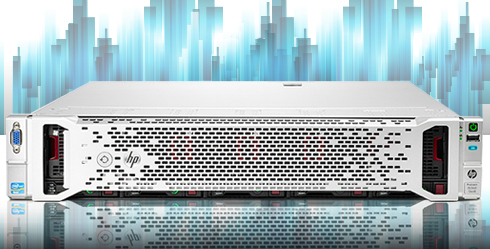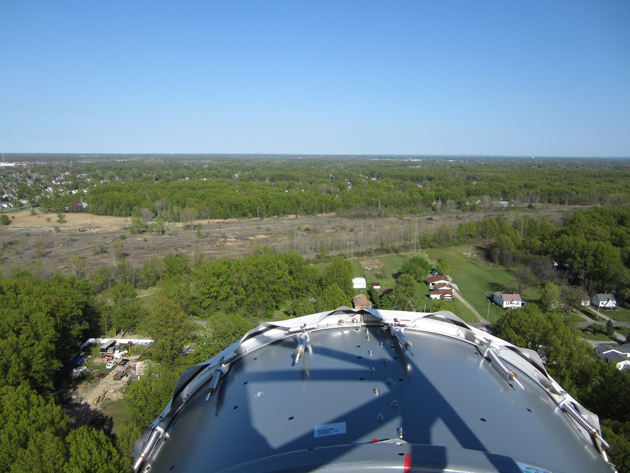Wall Street Technology Arms Race: An Inside Look

In the wild, often you will be killed, or you will kill yourself, whether you can eat or stay hungry is determined only by speed. Nowadays, the same can be said about the shady concrete jungle of the global financial markets. Those of the merchants who are not "high-frequency", give their money to high-speed traders (who now provide up to half of the total trading volume).
“By the time an ordinary investor sees a quote, he, roughly speaking, sees the light of a star flying 50,000 light years before him,” said Sal Arnuk, a partner at Themis Trading and co-author of a book called Broken Markets ", criticizing high-frequency trading.
')
Simply put, high-frequency merchants use a combination of hardware and software to understand earlier than others how much they want to sell or buy a certain stock at a given time. Having understood this, they can perform the corresponding operations. It's almost like betting on races, having been tentatively in the future - you already know who will come to the finish line first.
But this advantage cannot last for long. To stay ahead of the competition, such merchants have to constantly update their hardware, complicate the algorithms of trading applications, and spend money on more “wider” communication channels. Only fixed costs for all this allow the most successful of them to receive information before other traders.
“There is a large-scale technological arms race aimed at reducing transaction delays,” said Dave Lauer, a former HFT trader. "All because when you talk about delays in nanosecond and microsecond size, a millisecond is an eternity."
Lauer probably knows about the real state of things in the HFT better than others. He worked as a hardware engineer and created equipment that minimized delays, he was later an analyst and conducted quantitative research for HFT merchants, and then under the contract worked in a group of Goldman Sachs technical specialists. He wrote high-frequency trading algorithms, was engaged in mathematical modeling and was engaged in trade on prop-trading desch of large banks in New York and Chicago.
After being a trader for about two years, Lauer left the HFT industry. Then he wrote an article about it, which attracted enough attention for him to testify before US senators and sat at a round table on high-frequency trading, the Commission on Financial Markets (SEC). How does he see HFT?

Photo: Vincent Desjardins
High-frequency trading came to the attention of the public during the financial crisis of 2009, when the New York Times was one of the first to write about this topic. In fact, the concept of HFT actually appeared in 1999, when the Securities Commission allowed the registration of electronic trading platforms. In those days, however, everything revolved around software rather than hardware. Nevertheless, the essence of HFT is still the use of proprietary computer algorithms for high-speed trading in stocks and derivatives, entering and exiting positions in a split second.
In 2005, traders used Gigabit networks and quite ordinary equipment. Linux was also often used, although it was not particularly customizable, taking more time to quantify. However, as soon as some of the merchants realized that they could benefit from the so-called “ latency arbitrage ” (i.e., performing transactions faster than others), this was the beginning of an arms race, which aims to achieve zero delay.
When it comes to software and algorithms, fairly simple statistical arbitration models are used. “When delays are so important, you have limited room for maneuver,” explains Lauer. High-frequency traders work with huge amounts of market information and often use clusters of parallel computing to analyze it.
Very popular technologies like Hadoop with MapReduce . HFT traders are looking for mathematical structures and doing time series analysis - all to find something that can be “predicted”. A few years ago, one program studied the imbalances between supply and demand in the order queue (order book) on the exchange and simply tried to predict the next tick (upward or downward movement of the stock price). All this allowed to go into a plus on each transaction. Repeat such transactions a dozen or a hundred times a second (not to mention the fact that there is a possibility of not only “getting a plus, but earning more”) - and now you are earning real money, and very quickly.
HFT trading is at the forefront of hardware development. This means using hardware accelerated (hardware accelerated) network stacks or “custom” FPGAs . NASDAQ provides its ITCH data feed , processed by FPGA, rather than a stack of different programs. “Some people put data processing in FPGA,” says Lauer. Others use this technology to implement trade logic, process risks, and someone uses the GPU to perform large-scale parallel data processing on the fly. So in terms of hardware acceleration, really interesting things happen here, I think, more innovative than in other industries. ”
In terms of graphics processing technology (GPU), there is an interesting interaction between the gaming industry and the HFT: both areas are moving the technology forward, albeit in different ways. "Players" stimulate the development of rendering and processing of forms, "financiers" develop floating-point operations. In addition, the feedback that representatives of these two industries give to developers ultimately leads to the addition of cores, their acceleration and increasing parallelization. Lauer notes that “finance is the second most important industry for such [game] vendors, which means that they can earn more money here, respectively, and you can spend more on research.”

HP Proliant DL380p Gen8 server, the price of Yandex.Market is 169,000 rubles .
At the physical, stock exchange level, when it comes to HFT trading, this means using high-end servers like HPG8, located in racks in the exchange data centers or brokers ( colocation, for the Moscow Exchange available through ITinvest ) with a direct channel to the exchange. According to Lauer, all this allows for "order on the menu." “If you want a gigabit Ethernet, then it will cost you X. If you need 10-gigabit Ethernet, it’s already worth Y. Today, many who offer such 10-gigabit Ethernet, the cable will go straight to your Arista Switch“ through ”switch ($ 13000 ), which can deliver a packet to the server in nanoseconds, a special mechanism of which will send it directly to the memory, and all this will take a couple of microseconds. ”
It is important to understand that in high-frequency trading, absolute speed is practically unimportant, relative speed is what everyone aspires to. It does not matter if you are faster for 10 seconds or half a nanosecond, it is only important to overtake the fastest bidder. For example, when Lauer was a HFT merchant in 2009-2010, the Spread Networks dark fiber channel between Chicago ( Russians can easily get access to the stock exchange of this city ) and New York was the fastest: a super-low-frequency fiber-optic connection. (It was a few milliseconds faster than the public channel.)
But in the case of fiber, the beam of light “beats against the walls” of the channel as it moves, which introduces a certain delay. Therefore, McKay Brothers began building a dozen microwave signal repeaters between New York and Chicago ( for more details, see the “ High Frequency Trading Next Door ” translation cycle ). Microwaves are not subject to degradation and reflection of the signal present in the optical fiber, in addition, the signal goes along a more direct route than the cable, since the latter needs to bend around obstacles. “This is how you cut off a few milliseconds on the way from Chicago to New York,” explains Lauer.

McKay Brothers Microwave Repeater, panorama from Steve Ikam
Microwave technology allows transmission speeds close to the speed of light. However, it is also subject to external influences such as rain and fog, which reduce speed. Therefore, HFT merchants are looking for a weather-resistant solution that will provide higher speed. And these are lasers. (And not only traders, NASA sent a transmitter to the Moon, which sent data to Earth not by radio, but by means of a laser ).
But development continues on the ground too - Anova Technologies, a provider of low-patent and fiber-optic networks, has announced a patent for a hybrid system of laser and millimeter waves, which will provide speeds of up to 10 Gps. In April 2012, at a “ Battle of the Quanta ” conference in New York, one of the companies “lit up” the idea of using airships or drones scattered across the Atlantic from London to New York. “They estimate it will cost them $ 300 million,” says Lauer. And they think it's worth it, because people will pay for it. ”
Disregarding the wow factor, which is unavoidable when talking about drones sending laser signals across the ocean, it’s pretty hard to see how technical research by HFT merchants benefits the rest of society. At a fundamental level, the ability of some people to get market information faster than others may even look like a totally wrong thing, even fraud. In 2013, when the US Federal Reserve announced that it would not curtail the bond redemption program, several large orders were executed within milliseconds before this information officially reached the Chicago Stock Exchange.
“I still think this is crazy,” says Lauer, who left HFT due to doubts about the ethics of this business. It seems insane to me that huge amounts of capital — billions of dollars — are sent to “cutting off” milliseconds from the time a signal is transmitted between two places [exchanges]. Show me a person who has managed to explain the social good that is being created by reducing the transmission time between New York and Chicago by two milliseconds. Or between New York or London. No such people. This economical isolation of HFT trading from the real world still makes me recognize it as a harmful business, because if money is earned on this, then this money is not taken from the air, but from somewhere. That is, the price pays the society. "
But on Wall Street, HFT traders are real hyenas of the wild, and they use speed to steal someone else's prey.
Read also our other materials on high-frequency trading:
- Furious bulls: how Wall Street became dependent on high-speed trading [transfer cycle]
- High-frequency trading in the neighborhood [translation cycle]
- Nanex: A Nightmare on Elm Street for High-Speed Trading [translation cycle]
- Wall Street Wolf Hunters [translation cycle]
- Wolves of Wall Street: A story about high-frequency trading from the expert Thomson Reuters
- Books and educational resources on algorithmic trading
Source: https://habr.com/ru/post/261365/
All Articles